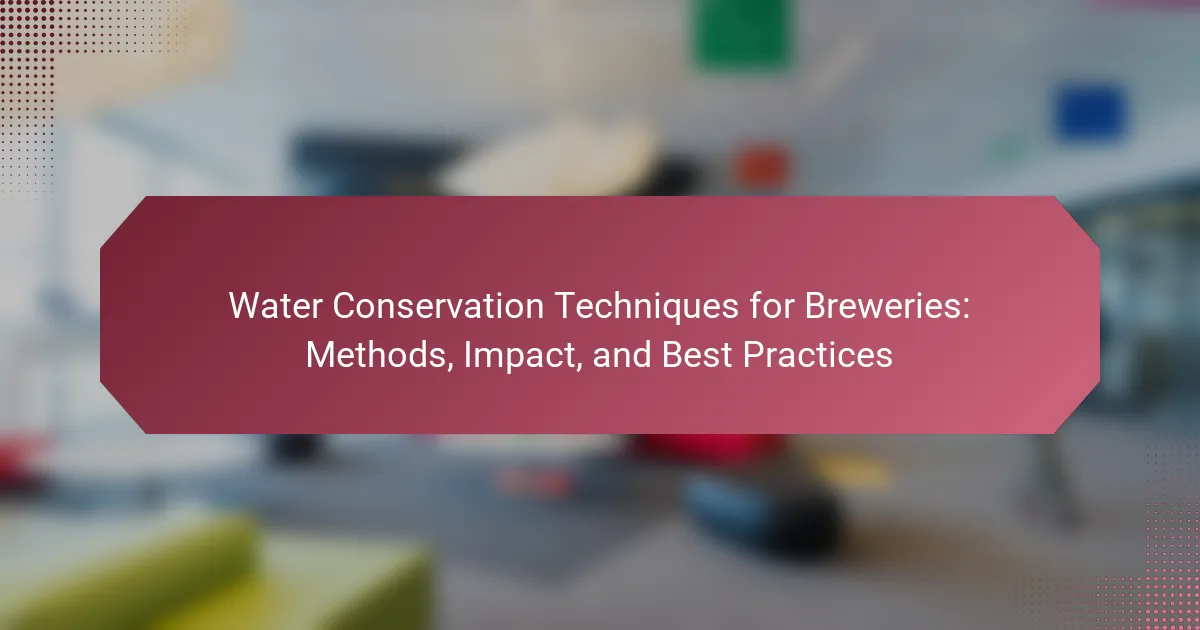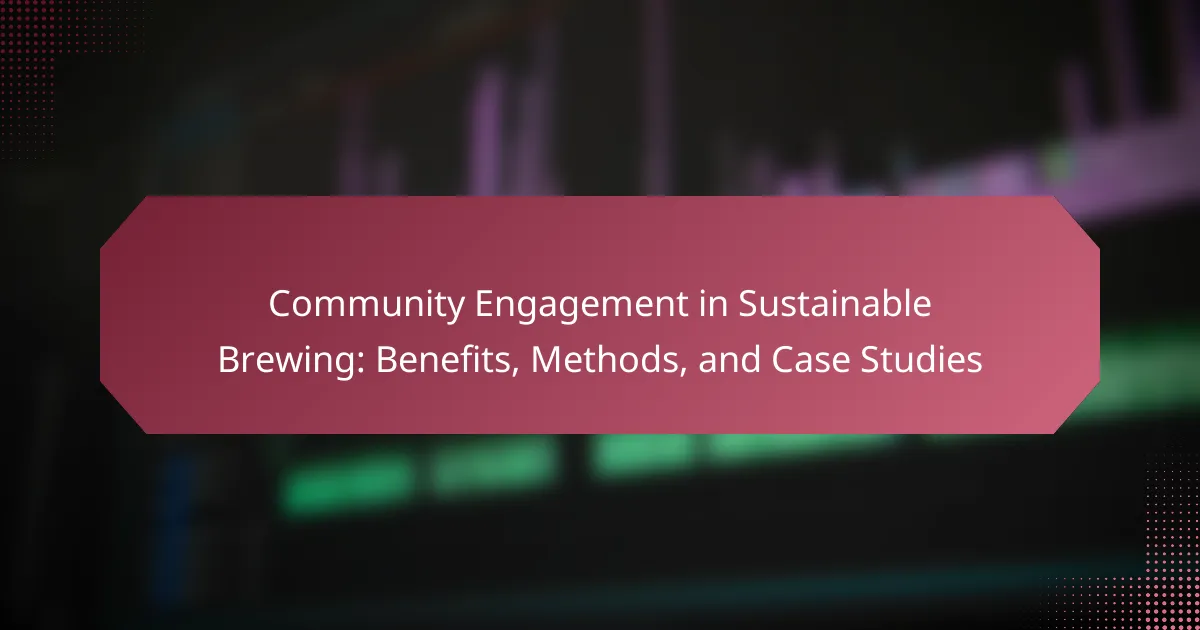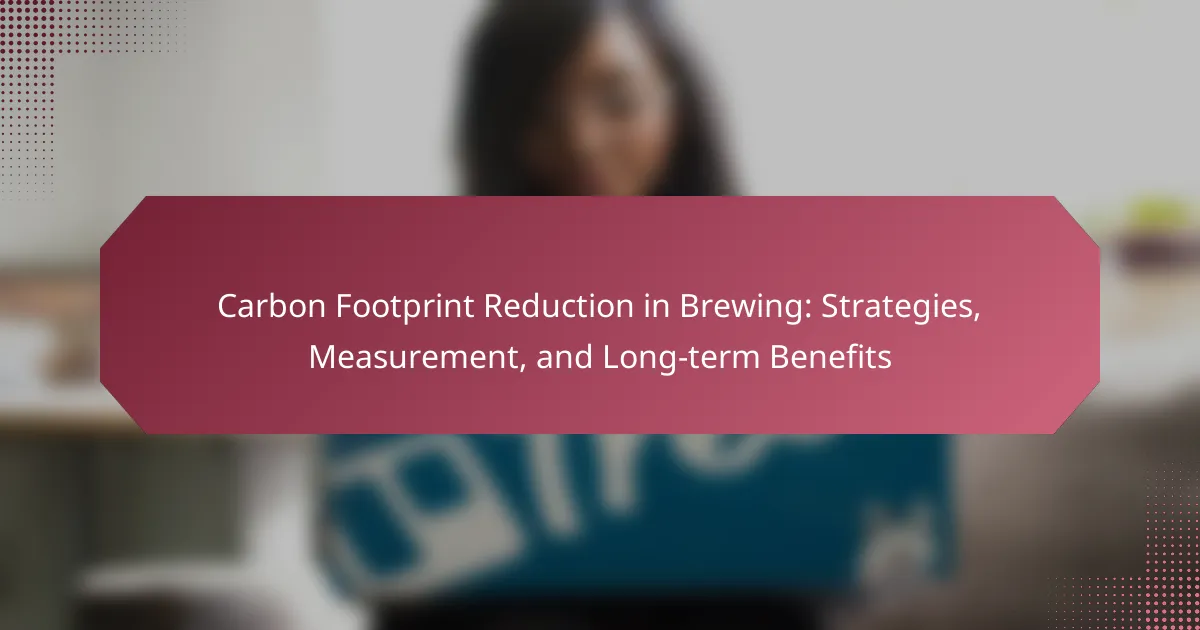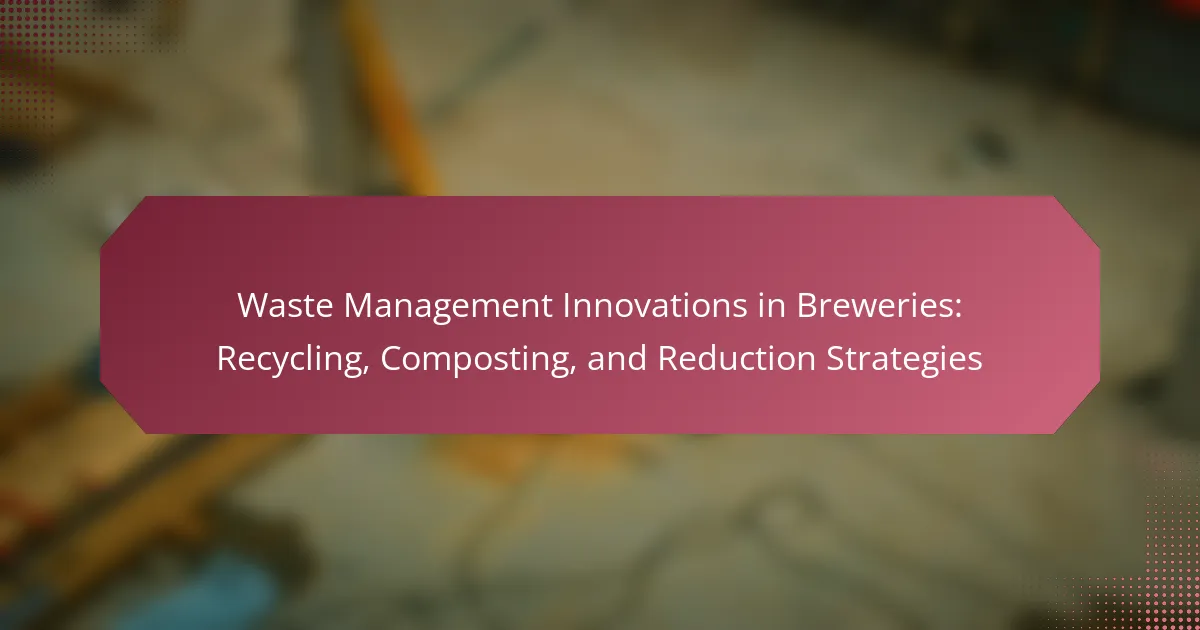Water conservation techniques for breweries are essential for reducing water usage and enhancing sustainability within the brewing industry. Key methods include water recycling systems, rainwater harvesting, and efficient cleaning systems, which collectively can decrease fresh water intake significantly. Best practices such as conducting water audits, optimizing cleaning processes, and training staff on water-saving measures further support these conservation efforts. Despite challenges like high water demands, lack of recycling infrastructure, financial constraints, and regulatory compliance, implementing these techniques can lead to substantial operational cost savings and environmental benefits.
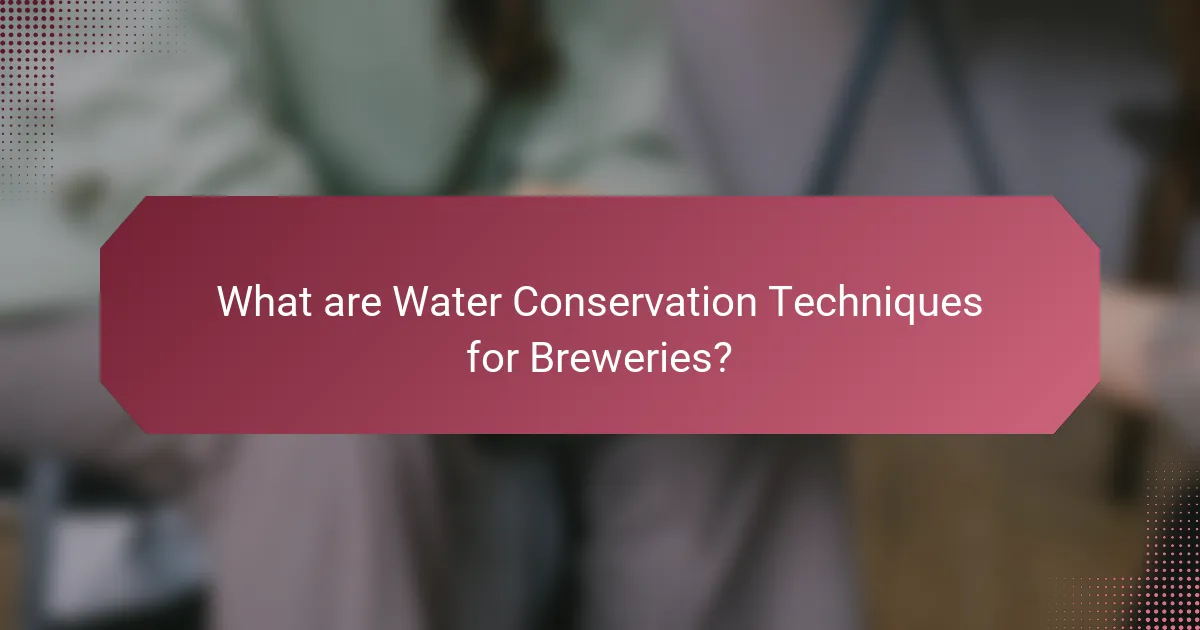
What are Water Conservation Techniques for Breweries?
Water conservation techniques for breweries include several effective methods. These methods aim to reduce water usage and improve sustainability. Techniques such as implementing water recycling systems can significantly decrease fresh water intake. Rainwater harvesting is another method that captures precipitation for brewery use. Utilizing efficient cleaning systems, like dry cleaning or low-water pressure systems, helps minimize water waste. Additionally, monitoring water usage through smart metering allows breweries to identify and address leaks promptly. Training staff on water-saving practices further enhances conservation efforts. According to the Brewers Association, implementing these techniques can reduce water usage by up to 50%.
Why is water conservation important for breweries?
Water conservation is crucial for breweries due to their high water usage in production. Breweries typically require about 4 to 7 gallons of water to produce just one gallon of beer. This significant consumption can strain local water resources, especially in drought-prone areas. Conserving water helps breweries reduce operational costs and improve sustainability. Efficient water use can also enhance the quality of the final product. Additionally, implementing water-saving technologies can lead to regulatory compliance and improved community relations. Studies show that breweries that adopt water conservation measures can save up to 30% on water costs. Therefore, water conservation is essential for both economic and environmental reasons in the brewing industry.
What are the environmental impacts of water usage in breweries?
Water usage in breweries significantly impacts the environment. Breweries consume large quantities of water, often averaging 4 to 7 gallons per gallon of beer produced. This high water demand can strain local water resources, especially in arid regions. Additionally, wastewater generated from brewing processes can lead to pollution if not properly treated. This wastewater may contain organic matter and chemicals that harm aquatic ecosystems. Excessive water extraction can disrupt local habitats and reduce biodiversity. Furthermore, the energy required to heat and treat water contributes to greenhouse gas emissions. Overall, the environmental impacts of water usage in breweries include resource depletion, pollution, habitat disruption, and increased carbon footprint.
How does water conservation affect brewery operations?
Water conservation significantly improves brewery operations. It reduces operational costs associated with water usage. Breweries often face high water bills, and conserving water can lead to substantial savings. Efficient water use also minimizes wastewater production, lowering treatment costs. Furthermore, sustainable practices enhance a brewery’s reputation. Consumers increasingly prefer environmentally responsible brands. Implementing water-saving technologies can lead to improved efficiency in brewing processes. Studies show that breweries can reduce water usage by up to 50% with effective conservation strategies. This not only supports the environment but also boosts profitability.
What are the common methods of water conservation in breweries?
Breweries commonly use several methods for water conservation. These methods include recycling wastewater for cleaning purposes. Many breweries implement rainwater harvesting systems to collect and use rainwater. They also employ efficient cleaning technologies to minimize water use. Some breweries utilize closed-loop systems to reduce water loss during production. Implementing water-efficient fixtures in restrooms and kitchens further aids conservation. Regular monitoring of water usage helps identify areas for improvement. According to the Brewers Association, breweries can save significant amounts of water by adopting these practices.
How can breweries implement water recycling systems?
Breweries can implement water recycling systems by installing treatment facilities for wastewater. These facilities can purify water for reuse in various brewery processes. Breweries can also capture and treat water from cleaning processes. This treated water can be repurposed for non-potable uses, such as equipment cleaning or irrigation. Additionally, breweries can utilize rainwater harvesting systems to supplement their water supply. Implementing these systems can reduce overall water consumption significantly. According to the Brewers Association, breweries can save up to 50% of their water through effective recycling practices.
What role does rainwater harvesting play in water conservation?
Rainwater harvesting plays a crucial role in water conservation. It involves collecting and storing rainwater for future use. This technique reduces reliance on traditional water sources. Breweries can benefit from rainwater harvesting by utilizing collected water for various processes. This includes cleaning, cooling, and even brewing. By using rainwater, breweries can significantly lower their water footprint. Studies show that rainwater harvesting can reduce water costs by up to 50%. Additionally, it helps mitigate stormwater runoff, promoting environmental sustainability. Overall, rainwater harvesting is an effective strategy for conserving water in breweries.
What are the benefits of adopting water conservation techniques?
Adopting water conservation techniques offers significant benefits for breweries. These techniques reduce water usage, leading to lower operational costs. Breweries can save thousands of gallons of water annually. This reduction also minimizes wastewater production, which lowers treatment costs. Improved efficiency in water usage enhances environmental sustainability. Additionally, conserving water can improve a brewery’s public image. Many consumers prefer brands that prioritize sustainability. Implementing these techniques can also comply with regulations and avoid penalties. Overall, water conservation techniques provide economic, environmental, and reputational advantages for breweries.
How do water conservation techniques impact brewery profitability?
Water conservation techniques positively impact brewery profitability by reducing operational costs. Breweries consume significant amounts of water, often leading to high utility bills. Implementing water-saving measures can lower these expenses. Techniques such as recycling wastewater or optimizing cleaning processes can save thousands of gallons annually.
For example, a brewery that reduces water usage by 20% can see a decrease in costs by approximately $10,000 per year, depending on local water rates. Additionally, conservation techniques can improve sustainability, attracting environmentally conscious consumers. This can lead to increased sales and brand loyalty.
Overall, effective water management not only cuts costs but also enhances a brewery’s market position.
What are the social benefits of water conservation in local communities?
Water conservation in local communities fosters social cohesion and enhances community well-being. It promotes collective action among residents to conserve resources. This shared goal strengthens relationships and builds trust within the community. Additionally, water conservation reduces utility costs for households. Lower bills can alleviate financial stress for families.
Engaging in conservation efforts often leads to educational initiatives. These programs raise awareness about environmental sustainability. They empower residents to take proactive steps in protecting their local ecosystems. Furthermore, communities that prioritize water conservation can improve public health. Clean water access is crucial for preventing waterborne diseases.
Research indicates that communities practicing water conservation experience increased civic engagement. Residents are more likely to participate in local governance and environmental initiatives. This active involvement can lead to improved community infrastructure and services. Overall, the social benefits of water conservation enhance quality of life and foster a sense of responsibility among residents.
How can breweries measure the impact of water conservation efforts?
Breweries can measure the impact of water conservation efforts by tracking water usage metrics before and after implementing conservation strategies. They can analyze the volume of water used per unit of beer produced. This data can be compared to historical usage records to identify reductions in water consumption. Additionally, breweries can assess changes in operational costs associated with water usage. Monitoring wastewater discharge levels can also provide insights into the effectiveness of water conservation initiatives. Utilizing tools such as water flow meters can enhance accuracy in measurement. Regular audits and reporting can help quantify the benefits of conservation efforts. These methods collectively offer a comprehensive view of water conservation impact in breweries.
What metrics should breweries track for water usage?
Breweries should track several key metrics for water usage. These include total water usage per batch of beer produced. Monitoring water usage helps identify efficiency levels in the brewing process. Breweries should also track water usage per unit of alcohol produced. This metric provides insight into the water-to-alcohol ratio. Additionally, tracking water usage in different brewing stages is essential. This includes mashing, boiling, and cleaning processes. Breweries can benefit from measuring the ratio of water used to water reclaimed. This helps evaluate water recycling efforts. Lastly, monitoring seasonal variations in water usage can inform conservation strategies. These metrics enable breweries to optimize water usage and reduce waste.
How can breweries assess the effectiveness of their conservation techniques?
Breweries can assess the effectiveness of their conservation techniques by measuring water usage before and after implementing these methods. They should track specific metrics such as water-to-beer ratio, effluent quality, and operational efficiency. Regular audits and benchmarking against industry standards provide additional insights. Surveys of employee engagement in conservation practices can also indicate effectiveness. Data analytics tools can help visualize trends over time. For instance, a brewery that reduced water usage by 20% after installing a recycling system can demonstrate the impact of its conservation efforts. Additionally, third-party certifications can validate conservation claims and enhance credibility.
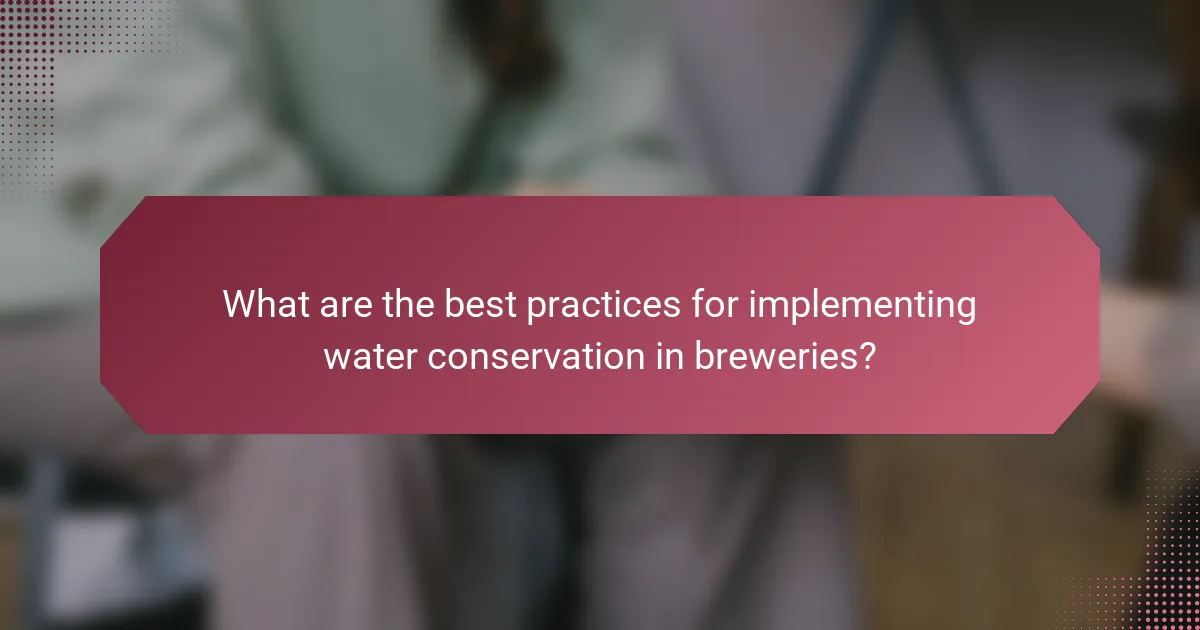
What are the best practices for implementing water conservation in breweries?
The best practices for implementing water conservation in breweries include conducting a water audit, recycling wastewater, and optimizing cleaning processes. A water audit identifies usage patterns and areas for reduction. Recycling wastewater can significantly lower fresh water demands. Implementing closed-loop systems minimizes water loss during production. Utilizing water-efficient equipment enhances overall efficiency. Training staff on water conservation practices fosters a culture of sustainability. Monitoring water usage regularly ensures ongoing improvements. These practices lead to reduced operational costs and environmental benefits.
What strategies can breweries adopt for effective water management?
Breweries can adopt several strategies for effective water management. Implementing water recycling systems allows breweries to reuse process water, reducing overall consumption. Installing efficient fixtures and equipment minimizes water waste during brewing and cleaning processes. Conducting regular audits identifies areas for improvement in water usage. Training staff on water conservation practices promotes a culture of sustainability. Collaborating with local water authorities can provide insights into best practices and regulations. Monitoring water usage through smart metering helps track consumption patterns and identify leaks. These strategies can lead to significant reductions in water usage, enhancing both environmental sustainability and operational efficiency.
How can staff training enhance water conservation efforts?
Staff training can enhance water conservation efforts by equipping employees with essential knowledge and skills. Trained staff understand the importance of water conservation in brewery operations. They can identify areas where water usage can be reduced. Training programs can introduce best practices for water-efficient processes. Employees learn to monitor water usage effectively. They become aware of the environmental impact of excessive water consumption. Research shows that breweries with trained staff can achieve up to 30% reduction in water usage. This reduction leads to significant cost savings and sustainability benefits.
What technologies can breweries use to improve water efficiency?
Breweries can use several technologies to improve water efficiency. Water recycling systems allow breweries to treat and reuse wastewater for various processes. These systems can reduce water consumption by up to 50%. Advanced filtration systems enhance the quality of recycled water, making it suitable for brewing. Smart water management software optimizes water usage by monitoring consumption in real-time. This technology can identify leaks and inefficiencies promptly. Additionally, heat exchangers recover heat from wastewater to pre-heat incoming water, reducing energy and water use. Implementing these technologies can lead to significant cost savings and environmental benefits for breweries.
How can breweries engage the community in water conservation initiatives?
Breweries can engage the community in water conservation initiatives by hosting educational workshops. These workshops can teach community members about the importance of water conservation. Breweries can also partner with local organizations to promote water-saving practices. Organizing community clean-up events near water sources can raise awareness. Breweries can implement water conservation challenges with local schools to encourage participation. Offering incentives for customers who adopt water-saving habits can further motivate community involvement. Collaborating with local governments on water conservation campaigns can amplify their impact. Sharing success stories through social media can inspire others to take action.
What partnerships can enhance water conservation efforts?
Collaborations between breweries and local governments can enhance water conservation efforts. These partnerships can lead to the implementation of sustainable practices. For example, breweries can participate in local watershed management programs. Such programs often focus on protecting water sources and improving water quality. Additionally, partnerships with environmental organizations can provide resources for water-saving technologies. Collaborating with agricultural sectors can promote the use of recycled water for irrigation. Research shows that breweries adopting these partnerships can reduce water usage by up to 30%. This reduction not only conserves water but also lowers operational costs.
How can breweries promote awareness about water conservation?
Breweries can promote awareness about water conservation by implementing educational campaigns. They can host workshops to inform the community about water-saving practices. Collaborating with local environmental organizations can amplify their message. Breweries can also use social media to share tips on reducing water usage. Displaying water conservation messages on product labels raises consumer awareness. Participating in community events can showcase their commitment to sustainability. Offering incentives for customers who support water conservation initiatives encourages participation. These actions help breweries position themselves as responsible stewards of water resources.
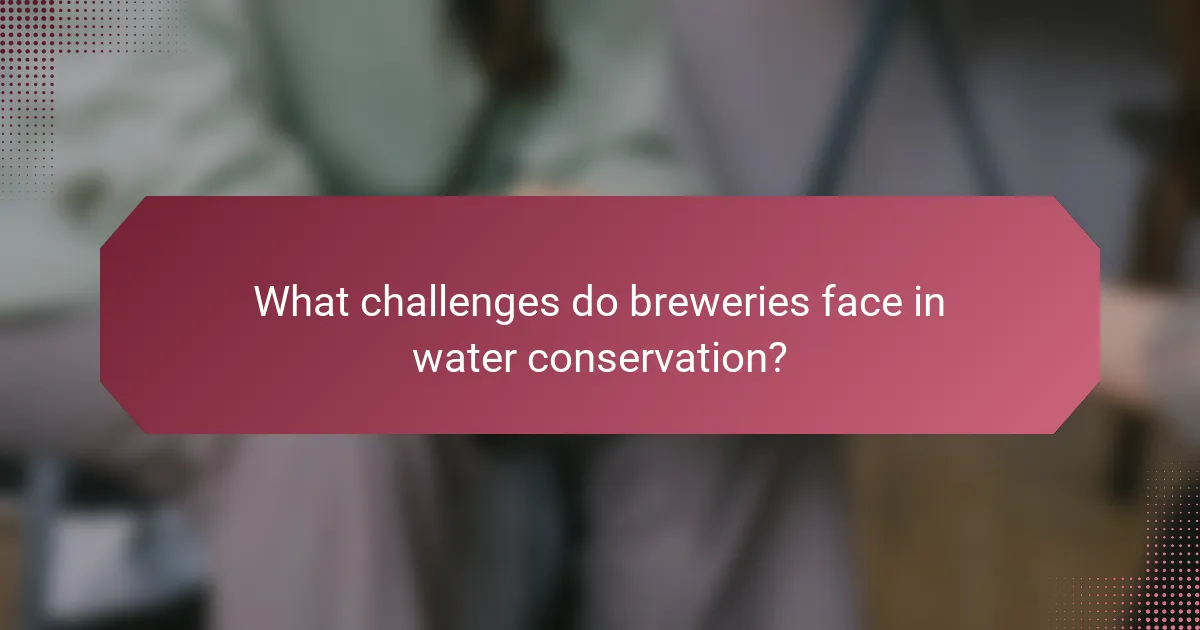
What challenges do breweries face in water conservation?
Breweries face several challenges in water conservation. One major challenge is the high water usage required for brewing processes. On average, breweries use approximately 4 to 7 gallons of water for every gallon of beer produced. This significant demand can strain local water resources, especially in drought-prone areas.
Another challenge is the lack of infrastructure for water recycling. Many breweries do not have the systems in place to treat and reuse wastewater effectively. This limits their ability to reduce overall water consumption.
Additionally, breweries often face financial constraints. Investing in water-saving technologies can be costly, deterring smaller breweries from implementing necessary changes.
Regulatory compliance can also pose challenges. Breweries must adhere to local water usage regulations, which can vary widely and complicate conservation efforts.
Lastly, there is a knowledge gap regarding best practices in water conservation. Many breweries lack access to resources or expertise on how to implement effective water-saving techniques.
What are common barriers to implementing water conservation techniques?
Common barriers to implementing water conservation techniques include high initial costs, lack of awareness, and insufficient training. High initial costs deter breweries from investing in new technologies. Many breweries may not be aware of the benefits of water conservation. Insufficient training can lead to improper use of conservation methods. Regulatory challenges may also complicate implementation. Limited access to resources can hinder the adoption of effective techniques. These barriers collectively reduce the effectiveness of water conservation efforts in the brewing industry.
How can financial constraints affect water conservation efforts?
Financial constraints can significantly hinder water conservation efforts. Limited budgets restrict investments in efficient technologies. Breweries may struggle to implement advanced water-saving systems. Reduced funding can lead to inadequate maintenance of existing equipment. Financial limitations may also prevent staff training on best practices. Consequently, water waste can increase due to inefficient processes. A study from the Water Research Foundation indicates that facilities with budgetary restrictions often report higher water usage. This highlights the direct correlation between financial resources and effective water conservation strategies.
What regulatory challenges might breweries encounter?
Breweries may encounter several regulatory challenges. These challenges often include compliance with local, state, and federal laws. Regulations can cover areas such as health and safety, environmental standards, and licensing requirements. For instance, the Environmental Protection Agency (EPA) enforces regulations on wastewater discharge. Breweries must also adhere to the Alcohol and Tobacco Tax and Trade Bureau (TTB) regulations. These regulations govern labeling, advertising, and production practices. Failure to comply can result in fines or operational shutdowns. Additionally, breweries may face zoning laws that restrict where they can operate. Understanding and navigating these regulations is crucial for successful brewery operations.
How can breweries overcome these challenges?
Breweries can overcome water conservation challenges by implementing efficient practices and technologies. They can adopt water recycling systems to reuse wastewater in the brewing process. Implementing rainwater harvesting can also supplement water supply. Breweries should regularly monitor water usage to identify areas for improvement. Training staff on water-efficient practices can enhance overall conservation efforts. Additionally, investing in advanced filtration systems can reduce water waste. Collaborating with local authorities for sustainable water management can provide further support. These strategies can lead to significant reductions in water consumption and operational costs.
What funding opportunities are available for water conservation projects?
Funding opportunities for water conservation projects include federal grants, state programs, and private foundations. The U.S. Environmental Protection Agency (EPA) offers grants under the Clean Water State Revolving Fund. Many states have their own funding programs for water efficiency initiatives. Non-profit organizations also provide grants for innovative water conservation projects. The USDA offers funding through its Rural Development program for water-saving technologies in agriculture. Additionally, local water utilities may have rebate programs for businesses that implement water-saving measures. These funding sources help support the development and implementation of effective water conservation strategies.
How can breweries learn from successful case studies?
Breweries can learn from successful case studies by analyzing the strategies and outcomes of other breweries. They should identify key practices that led to water conservation success. Case studies often provide specific metrics, such as reduced water usage percentages. For example, a brewery may showcase a 30% reduction in water consumption after implementing a closed-loop system.
Breweries can also evaluate the challenges faced by peers and how they overcame them. Understanding the context of each case study helps breweries tailor solutions to their unique operations. Additionally, breweries can adopt innovative technologies highlighted in case studies. These technologies may include advanced filtration systems or rainwater harvesting methods.
By benchmarking against successful examples, breweries can set realistic goals. They can track progress and make data-driven decisions. Ultimately, learning from these case studies can lead to improved sustainability practices and operational efficiency.
What practical tips can breweries follow for effective water conservation?
Breweries can implement several practical tips for effective water conservation. First, they should conduct a water audit to identify usage patterns and inefficiencies. This helps in understanding where water is being wasted. Second, breweries can invest in water-efficient equipment, such as low-flow faucets and high-efficiency washers. These tools significantly reduce water consumption. Third, recycling wastewater for cleaning or cooling processes can minimize overall water use. Fourth, breweries should train staff on water-saving practices to promote awareness and responsibility. Additionally, they can explore rainwater harvesting systems to supplement their water supply. Lastly, regular maintenance of plumbing and equipment prevents leaks and reduces unnecessary water loss. These strategies collectively contribute to significant water conservation in brewing operations.
What simple changes can make a significant impact on water usage?
Implementing low-flow faucets and showerheads can significantly reduce water usage. These fixtures can save up to 60% more water compared to traditional models. Regularly checking for leaks can also have a major impact. Fixing leaks can save approximately 10,000 gallons of water annually for a single household. Additionally, using efficient irrigation systems can minimize water waste in landscaping. Drip irrigation systems use 30-50% less water than conventional sprinkler systems. Collecting rainwater for outdoor use is another effective method. Rain barrels can capture hundreds of gallons during a rainfall. Lastly, adjusting watering schedules based on weather conditions prevents unnecessary water usage. These simple changes can collectively lead to substantial water conservation.
How can breweries create a culture of conservation among employees?
Breweries can create a culture of conservation among employees by implementing comprehensive training programs. These programs should educate staff on the importance of water conservation in brewing processes. Regular workshops can reinforce best practices and share success stories. Encouraging employee participation in sustainability initiatives fosters ownership and engagement. Breweries can implement incentive programs that reward conservation efforts. Establishing clear goals for water usage reduction can motivate employees. Open communication about water conservation impacts strengthens team commitment. Tracking and sharing progress can highlight achievements and areas for improvement.
The main entity of this article is water conservation techniques specifically for breweries. The article provides an in-depth exploration of various methods that breweries can adopt to reduce water usage, such as recycling systems, rainwater harvesting, and efficient cleaning technologies. It discusses the importance of water conservation for economic and environmental sustainability, as well as the challenges breweries face in implementing these techniques. Additionally, the article outlines best practices for effective water management and emphasizes the social benefits of conservation efforts in local communities.
